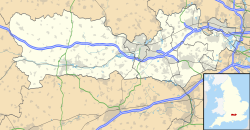| Site of Special Scientific Interest | |
 Rack Marsh | |
| Location | Berkshire Wiltshire |
|---|---|
| Grid reference | SU 370 691 [1] |
| Coordinates | 51°25′12″N1°28′08″W / 51.420°N 1.469°W |
| Interest | Biological |
| Area | 23.4 hectares (58 acres) [1] |
| Notification | 1996 [1] |
| Location map | Magic Map |
Kennet and Lambourn Floodplain is a 23.4-hectare (58-acre) biological Site of Special Scientific Interest in six widely separated areas in the floodplains of the River Lambourn in Berkshire and the River Kennet in Wiltshire, England. [1] [2] It is a Nature Conservation Review site [1] and part of the Kennet and Lambourn Floodplain Special Area of Conservation. [3] One of the areas, Rack Marsh, is managed by the Berkshire, Buckinghamshire and Oxfordshire Wildlife Trust. [4]
These six areas all have fen or swamp with large numbers of Desmoulin's whorl snail, which is listed in the British Red Data Book as it is a nationally rare and declining species. One of the areas, Eddington Marsh, also has unimproved species-rich grassland with several nationally scarce invertebrates, such as the flies Pherbellia griseola , Psacadina verbekei , Platypalpus niger and Oxycera morrisi . [5]
